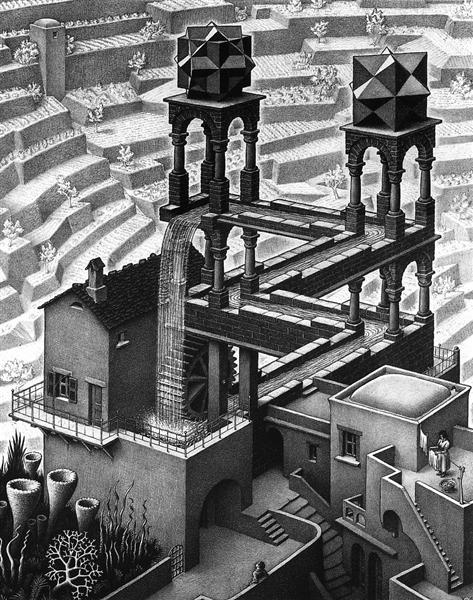Maurits Escher, who gave the world amazing paintings of “impossible reality”, was one of the most famous artists of the imp-art direction. His works were far from always understood by the public, for which they were repeatedly criticized. However, the creations of the ingenious graphic artist, no doubt, belong to the elite art, ambiguous, but always arousing interest.
Escher’s engraving “Waterfall” is the most famous creation of the master, quite often quoted, and illustrations with his image can be found even in mathematical textbooks. It is noteworthy that Maurits Escher himself was never a brilliant connoisseur of the exact sciences, either in his youth or in a more mature age. Geometry was not given to him, as, by the way, drawing was not given either – at least in these subjects he received mediocre grades. Nevertheless, Escher had a talent for painting. Subsequently, he graduated from the School of Decorative Arts in Haarlem and came to grips with what attracted him most: graphics, in particular, woodcuts, metal, linoleum.
The painting “Waterfall” is made in the technique of lithography – a technique of flat printing, in which the image is transferred from stone to paper. This work was painted by Escher in 1961, when the artist for more than a dozen years preferred to create works containing complex geometric shapes. Engraving, on the other hand, as a way of obtaining an image, interested him from his youth: some researchers of the artist’s work believe that his love for creating identical prints and repeating drawings began to form in him already at that time.
Escher Maurits drew his “Waterfall” based on the Penrose triangle – one of the main impossible figures about which the famous mathematician Roger Penrose wrote an article in 1958. Thus, Escher, who was never a physicist or mathematician, most of his life was associated with these sciences and those who dealt with them professionally. He himself said that he should consider himself more a scientist than an artist.
Composition based on the painting by Maurits Escher “Waterfall”
Distorted space, the logic of space deliberately violated when depicting clear geometric constructions – those features of the artist’s work that delighted mathematicians around the world and art lovers. The plot of Escher’s engraving “Waterfall” is built on them – with a cursory glance, the inaccuracies are not too noticeable, but upon closer examination, the very “impossible reality” appears, which the human brain is unable to perceive. Following the lines with your eyes, it is impossible to see what exactly the impossibility of the existence of such structures consists in, however, when considering the whole picture as a whole, the inconsistencies are obvious.
In the painting Waterfall, the artist depicted two towers, which are two connected Penrose triangles. Between them is a mill wheel, which sets in motion, in fact, the waterfall. It is assumed that the water spins the wheel, rushing down from the topmost tower. Judging by the figure, the same wheel directs the water upward in a circle, which is impossible given the current laws of physics. The painting “Waterfall” illustrates a non-existent perpetual motion machine.
As for the rest of the details, they are all depicted with perspective distortion. The towers, at first glance, are the same in height, upon close examination they are not. The entire plane along which the water flows seems to be horizontal or inclined, depending on the direction of the gaze.
The effect of the impossibility of the engraving “Waterfall”, the genius creation of Maurits Escher, is enhanced by the real details depicted on it. The house on the bottom right looks quite normal, apart from the quirkiness of the architecture, there is nothing strange in the appearance of a woman either. Only the plants located in the lower left corner are amazing in shape and size.
Currently, the brilliant work is in The Hague. Here is the Escher Museum, whose permanent collection includes the most famous works of the artist.
Year of painting: 1961.
The size of the painting: 38.1 × 29.9 cm.
Writing technique: lithography.
Genre: capriccio.
Style: surrealism.
Gallery: National Gallery of Art, Washington, USA.
